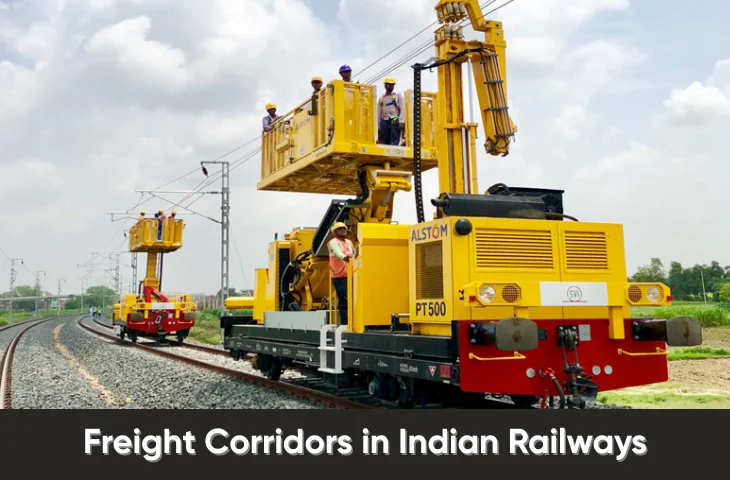Freight Corridors in Indian Railways: Indian Railways has long been the backbone of freight movement in the country, handling over a billion tonnes of goods annually. However, with rising demand for faster, reliable, and cost-effective logistics, the traditional system of goods transport often faces bottlenecks due to shared tracks with passenger trains. To overcome this, freight corridors in Indian Railways were conceptualized as dedicated high-capacity rail networks exclusively for goods trains.
This article examines the comparison between freight corridors and conventional goods transport in terms of efficiency, costs, and long-term benefits.
What is the Importance of Freight in Indian Railways?
The importance of freight in Indian Railways lies in the transportation of coal, cement, food grains, iron ore, and more. Check out the details given below:
- Freight contributes nearly two-thirds of the revenue of Indian Railways.
- Goods carried include coal, cement, food grains, iron ore, fertilizers, and consumer goods.
- Traditional goods trains operate on mixed-use tracks, competing with passenger services for time slots.
While efficient to an extent, this model leads to delays, congestion, and lower speeds, making freight less competitive compared to road transport.
Emergence of Freight Corridors in Indian Railways
To modernize the system, the Dedicated Freight Corridor Corporation of India Limited (DFCCIL) was set up in 2006. It is tasked with creating high-capacity, high-speed freight-only tracks. Some of the key objectives include:
- Reduce congestion on passenger lines.
- Increase average freight train speeds from 25 km/h to 70–100 km/h.
- Enable longer and heavier trains, lowering the cost per tonne.
- Provide eco-friendly logistics by shifting goods transport from road to rail.
| Corridor | Route | Length (approx.) | Status |
| Eastern Freight Corridor | Ludhiana to Dankuni | ~1,856 km | Largely operational |
| Western Freight Corridor | Dadri to JNPT (Mumbai) | ~1,504 km | Nearing completion |
| North-South Corridor | Delhi to Chennai | ~2,173 km | Proposed |
| East-West Corridor | Kolkata to Mumbai | ~2,328 km | Proposed |
| East-South Corridor | Kharagpur to Vijayawada | ~1,114 km | Proposed |
Conventional Goods Transport Challenges
Goods trains currently run on the same tracks as passenger trains. This creates multiple issues:
- Low Average Speed: Freight trains often stop to give way to high-priority passenger trains.
- Congestion: Shared tracks result in delays, especially on high-density routes.
- Limited Capacity: Wagons per train and axle loads are restricted.
- Higher Costs: Frequent stoppages and longer turnaround times increase expenses.
- Environmental Concerns: Road freight becomes a preferred choice, adding to carbon emissions.
How Freight Corridors Improve Goods Transport Efficiency?
Freight Corridors help in the efficiency of goods transportation up to a limit of 13,000 tonnes. Some of the key efficiency gains are as follows:
- Higher Speeds: Average speed of freight trains expected to rise to 70–100 km/h.
- Increased Capacity: Trains can carry up to 13,000 tonnes compared to 5,000 tonnes in conventional systems.
- Reliability: No waiting for passenger trains, ensuring timely delivery.
- Cost Reduction: Lower fuel consumption and economies of scale.
- Green Transport: Lesser dependence on road transport, reducing emissions by 50%.
| Parameter | Conventional Goods Transport | Freight Corridors in Indian Railways |
| Average Speed | 25 km/h | 70–100 km/h |
| Train Load Capacity | 5,000 tonnes | 13,000 tonnes |
| Reliability | Frequent delays | On-time, dedicated routes |
| Operational Costs | Higher due to congestion | Lower per tonne |
| Environmental Impact | Higher emissions | Eco-friendly, energy-efficient |
| Passenger Train Delays | Common due to freight trains | Reduced due to segregation |
Economic Impact of Freight Corridors
There are huge economic impacts on freight corridors. Some of the major economic impacts are as follows:
- Boost to GDP: Faster and cheaper logistics could add nearly 1% to India’s GDP.
- Industrial Growth: Smoother supply chains will benefit cement, steel, power, and FMCG sectors.
- Trade Competitiveness: Ports like JNPT and Kolkata will be better connected to hinterlands.
- Job Creation: Thousands of direct and indirect jobs in construction, logistics, and allied sectors.
Challenges in Implementation
While promising, freight corridors also face hurdles. The key challenges in the implementation are as follows:
- Land Acquisition Issues are delaying projects.
- High Capital Costs—estimated at over ₹80,000 crore for the first two corridors.
- Technology Integration with existing railway networks.
- Coordination with States for smooth execution.
Future Outlook
The successful rollout of freight corridors will mark a new era in Indian logistics. Once operational, these corridors could:
- Make Indian Railways a global benchmark for freight transport efficiency.
- Reduce logistics costs from 14% of GDP to under 9%.
- Encourage industries to shift from road to rail freight, ensuring sustainable development.
Key Points of Freight vs Goods Transport Efficiency in Indian Railways
We have summarized some key points of the article. Make sure you follow this table for a quick look:
| Aspect | Conventional Goods Transport | Freight Corridors in Indian Railways |
| Track Usage | Shared with passenger trains | Exclusive freight-only lines |
| Speed | 25 km/h average | 70–100 km/h average |
| Capacity | Limited to ~5,000 tonnes | Up to 13,000 tonnes |
| Reliability | Prone to delays | High reliability |
| Cost Efficiency | Moderate | Highly cost-efficient |
| Environmental Impact | More emissions | Cleaner and greener |
| Overall Efficiency | Moderate | Transformational |
Freight transport is the lifeline of Indian Railways, and the introduction of freight corridors in Indian Railways is a game-changer. By improving speed, efficiency, and reliability, these corridors will not only decongest existing passenger routes but also boost India’s economic competitiveness and sustainability.
FAQs
Freight corridors in Indian Railways are conceptualized as dedicated high-capacity rail networks exclusively for goods trains.
By improving speed, efficiency, and reliability, these corridors will not only decongest existing passenger routes but also boost India’s economic competitiveness and sustainability.
The economic impacts of freight corridors lie in boosting GDP, industrial growth, job creation, and more.
Freight contributes nearly two-thirds of the revenue of Indian Railways.
Some of the key points for the future outlook of freight corridors include:
Make Indian Railways a global benchmark for freight transport efficiency.
Reduce logistics costs from 14% of GDP to under 9%.

Hello! This is Arijit Dutta. I am a skilled Content Writer at Oliveboard with nearly 3+ years of experience in crafting engaging, informative, and exam-focused content for the Railways Domain. With a strong command of language and a keen understanding of learner needs, I contribute significantly to Oliveboard’s mission of delivering high-quality educational resources. Passionate about clear communication and continuous learning, I consistently create content that helps government job aspirants achieve their goals. Outside of work, I enjoy playing cricket and listening to music, which helps me stay balanced and creative in my professional journey.
